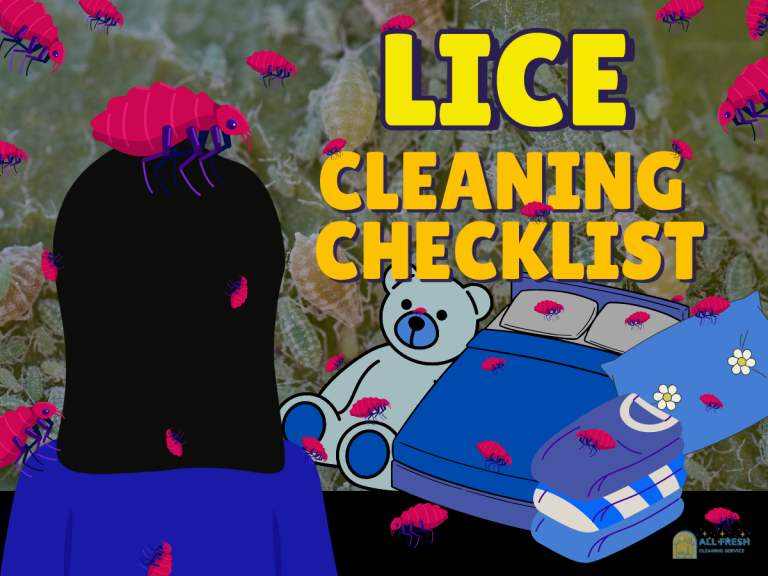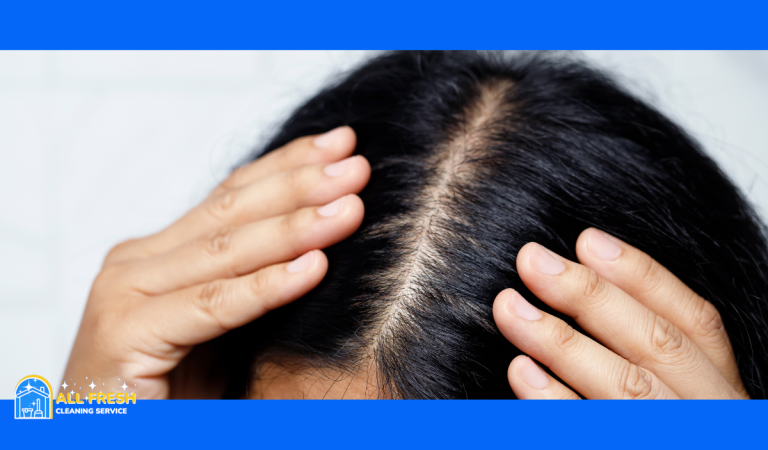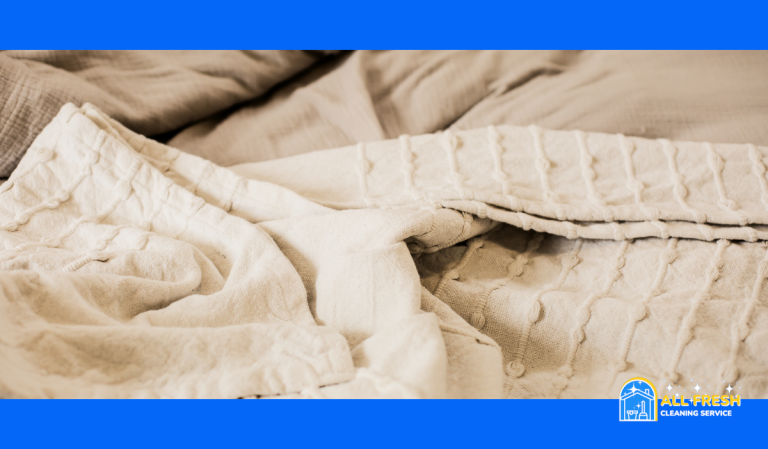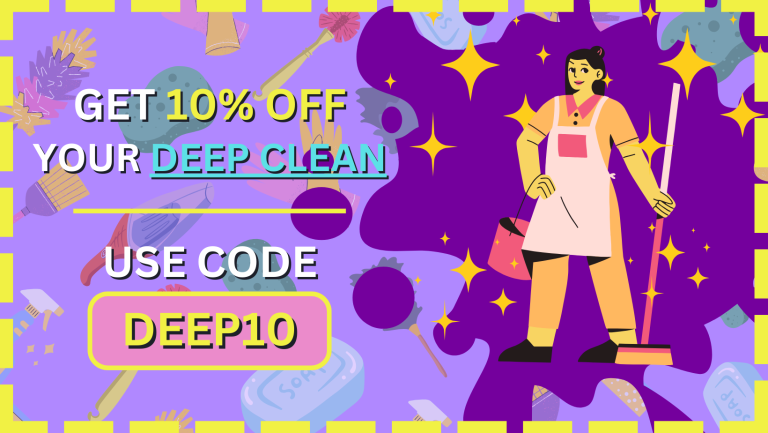
Dealing with lice can be a stressful and unsettling experience. Once you’ve addressed the unwelcome guests on your scalp, it’s time to turn your attention to your home to prevent re-infestation.
Think of it as giving your living space a good spring cleaning, except… you’re evicting those gross and disgustingly tiny critters as well.
This guide will walk you through the process of identifying lice, performing a head check, and using effective cleaning methods to get rid of lice and prevent it from returning.
Signs of Having Lice
Lice are tiny, parasitic insects that live on the scalp and feed on human blood.
Common signs of lice include:
- Itching: That relentless scratching can drive anyone up the wall!
- Red Bumps: You might notice some irritation on your scalp—another red flag!
- Nits: These small white eggs can cling to your hair strands like they’re at a party they never want to leave.
If you or a loved one is constantly scratching their head, it’s time to investigate further, especially considering how lice can also transfer to bedding and furniture, causing concerns like how long can lice live on a pillow.
How to Identify Lice
When it comes to dealing with lice, knowledge is your best ally.
Understanding how to identify these troublesome parasites is crucial for taking this infestation head-on. But don’t worry! You don’t need a magnifying glass or a PhD in entomology to spot them.
In this section, we’ll break down the different life stages of lice you might encounter—adults, nymphs, and nits—and share handy tips on where to look and what to look for.
So, get ready to become a lice detective; with the right information, you’ll be equipped to take action and reclaim your scalp! And also, be prepared to be slightly grossed out by reading the bodily description of these things….
Adult Lice:
- Size of a sesame seed (2-3 mm long)
- Typically grayish-white or tan in color
- Got 6 legs with claws
- They move quickly and are most commonly found on the scalp, behind the ears, and at the base of the neck.
- They may also fall off onto surfaces, raising the question of can lice live on pillows or lice in the bathtub.
Nymphs (Baby Lice):
- Smaller size of 1-2 mm long
- They’re harder to spot
- Translucent when first hatched but darken as they grow
- Usually find them in the same places as adult lice, near the scalp
- Proper detection is key to figuring out how to comb out head lice effectively
Nits (Lice Eggs):
- TINY size of a pinhead
- White or yellow in color
- Typically glued to hair strands close to the scalp, making them difficult to remove
- Requires thorough combing and patience
- After the eggs are hatched, white and clear shells are attached to the hair shaft
- Kind of looks like dandruff but not easily shaken off
How to Do a Head Check for Lice
Ready to play detective?
Grab a fine-toothed comb and start parting the hair in small sections. Look closely, especially around the ears and the nape of the neck, as these are prime real estate for lice.
Good lighting is your best friend here—spotting even the tiniest lice or nits can make all the difference. Once you’ve acknowledged the fact you got a lice gathering happening in your space, it’s time to not just wage war on lice for your scalp…but also for your home.
How to Clean Your Head for Lice

Alright, now that you identified you got a lice problem (so unfortunate and I’m genuinely sorry you’re going through this), it’s time to get to the most crucial part: treating your scalp!
Without proper treatment, lice can come back faster than a bad sequel, even after cleaning your home.
Materials/Tools You Need to Get Rid of Lice on Your Head:
- Fine-tooth lice comb: Your trusty sidekick in the battle against nits.
- Specialized lice shampoo: The MOST important tool you can have.
- Towel: To keep things tidy.
- Rubber gloves: Just in case!
Here are some popular brands for specialized lice shampoos, including both conventional and natural options:
Conventional Lice Shampoos:
RID Lice Shampoo: A well-known and widely used treatment for lice, effective in killing both adult lice and their eggs.
Nix Lice Shampoo: Another popular choice, often recommended by healthcare professionals for its effectiveness and ease of use.
LiceMD Lice Treatment Shampoo: This product is known for its unique, pesticide-free formula that uses dimethicone to suffocate lice.
Natural Lice Shampoos:
Fairy Tales Rosemary Repel Shampoo: Made with natural ingredients like rosemary and peppermint, this shampoo is designed to repel lice and is safe for children.
Lice Freee! Natural Lice Treatment: Uses natural ingredients and is free from harsh chemicals, making it suitable for all ages.
Fresh Heads Lice Removal: This natural shampoo effectively eliminates lice and nits using natural ingredients, making it safe for the whole family while providing a gentle yet powerful treatment.
Step-by-Step Process on How to Get Rid of Lice on Your Head:
Apply Lice Shampoo: Follow the instructions carefully—let it sit long enough to suffocate and kill those lice.
Rinse and Dry: Wash your hair thoroughly and dry it using a clean towel. Some folks wonder, does showering get rid of lice? It helps, but combing is where the magic happens.
Comb it Out: Use your fine-tooth comb to meticulously remove lice and nits from wet hair. Work in small sections to ensure you catch them all, answering how to remove lice nits easily and how to take out lice eggs.
Repeat the Process: Do this every few days to ensure no lice remain. For an extra edge, blow-drying can help, but consult professionals for guidance.
How to Get Rid of Lice in Your Home

Once you’ve dealt with lice on your head, it’s time to cleanse your home as if you’re preparing for a royal visit.
Lice can survive off the scalp for a bit, so knowing how long can lice live on bedding (which is answered in the FAQ section) is crucial to preventing a re-infestation.
Materials/Tools You Need to Deep Clean Your Home for Lice:
- Vacuum cleaner
- Lice bomb or lice spray for house (like an all-purpose lice spray)
- Laundry detergent
- Hot water and dryer
- Disinfectant spray (while Lysol kills lice on surfaces, it’s not the most effective for complete eradication)
- Fine-tooth lice comb (like the best comb for lice)
- Trash bags for items that can’t be washed
- Rubber gloves
Here are some of the best and most affordable lice sprays:
Top-Rated and Budget-Friendly Lice Sprays:
RID Lice Killing Spray: Highly rated for its effectiveness in killing lice and their eggs.
Nix Lice Treatment Spray: Well-known for its efficacy and is often recommended by healthcare professionals.
Lice Freee! Lice Treatment Spray: Uses natural ingredients and is safe for all ages.
LiceShield Lice Repellent Spray: Effective as a preventive measure against lice, especially for children.
Step-by-Step Process on How to Deep Clean Your Home for Lice:
- Vacuum: Start with a thorough vacuuming of carpets, rugs, and furniture. Don’t forget to target spots where the infested person spent the most time. How long can lice live on a couch? Up to 48 hours!
- Wash Everything: Toss all bedding, clothing, and towels into the washer with hot water. Dry on high heat for at least 30 minutes to kill lice and nits. This helps with concerns like can nits live in bedding and head lice bed linen.
- Lice Spray or Lice Comb on Soft Surfaces: Use a lice bomb or lice spray on soft surfaces like couches and mattresses.
- Bag Non-Washable Items: Stuffed animals? Seal them in airtight plastic bags and store them for at least two weeks to suffocate any lingering lice, addressing the question can lice live on couches or lice on clothes.
- Clean Combs and Brushes: Soak combs and brushes in hot water (at least 130°F) for 5-10 minutes. To go the extra mile, use disinfectant spray after soaking.
- Wipe Down Hard Surfaces: Disinfect counters and floors to eliminate any remaining lice. Soaking plastic combs in boiling water is an effective way to clean them thoroughly. Wondering how to clean a plastic comb or how to sterilize a comb? Soaking them in boiling water works wonders.
- What kills lice on furniture? Using high heat or chemical lice sprays can effectively eradicate lice hiding in upholstery.
Key Takeaways on How To Kill Lice:
- Address both your head and home when tackling lice.
- Washing bedding, clothes, and soft furnishings in hot water is essential.
- Regular vacuuming, using lice bombs, and disinfecting combs are crucial to keeping lice at bay.
- Can a hair dryer kill lice and nits? Yes, but it’s most effective when combined with other methods.
Conclusion
Lice infestations are a nuisance, but with proper treatment and cleaning, they are manageable. By following this lice cleaning checklist, you’ll be armed and ready to eliminate lice from both your head and your home. No more worrying about those little buggers returning!
Hey, if you’re feeling overwhelmed and just want to eliminate all that grossness from your scalp and home, it’s a smart move to reach out to a lice removal professional. They’ll help you get your space and life back to normal!
Get Rid Of Lice FAQ
How long can lice live on stuffed animals?
Lice can hang out on stuffed animals for up to 48 hours. It’s best to seal them in a plastic bag for two weeks to suffocate any remaining lice.
Can disinfectant spray kill lice?
Disinfectant sprays like Lysol can disinfect surfaces but aren’t the best for killing lice directly. Consider using an all-purpose lice spray instead.
What’s the best way to rid head lice?
The best method involves using a lice treatment shampoo followed by thorough combing to remove lice and nits. And also by following through with a deep clean of your living space (especially where the infected person dwells the most!) and by diligently cleaning the beddings & objects affected.
How do you treat your house for lice?
Clean all surfaces, vacuum, wash bedding and clothing in hot water, and use a lice spray for the house.
How long does a lice live on a pillow?
Just like with furniture and carpets, adult lice can survive on pillows and sheets for about 2 days without human contact. Nits, on the other hand, won’t hatch and will die within a week.
To make sure a thorough clean, it’s super crucial to machine wash any pillows or sheets used by someone with lice in hot water exceeding 130°F (54.4°C).
How to remove lice from hair permanently at home?
The best way to be rid of lice permanently at home is by following all those steps and by maintaining the living space doing regular vacuuming, using lice bombs occasionally, and using disinfecting combs are great ways to make sure they don’t come back.
How long can lice live on bedding without a host?
Head lice can generally survive on bedding for about one to two days without a human host, with adult head lice thriving for one to two days at temperatures around 86°F and up to four days at 74°F.
Nits, on the other hand, can linger for up to ten days, although they won’t hatch if the temperature is at or below 68°F.

